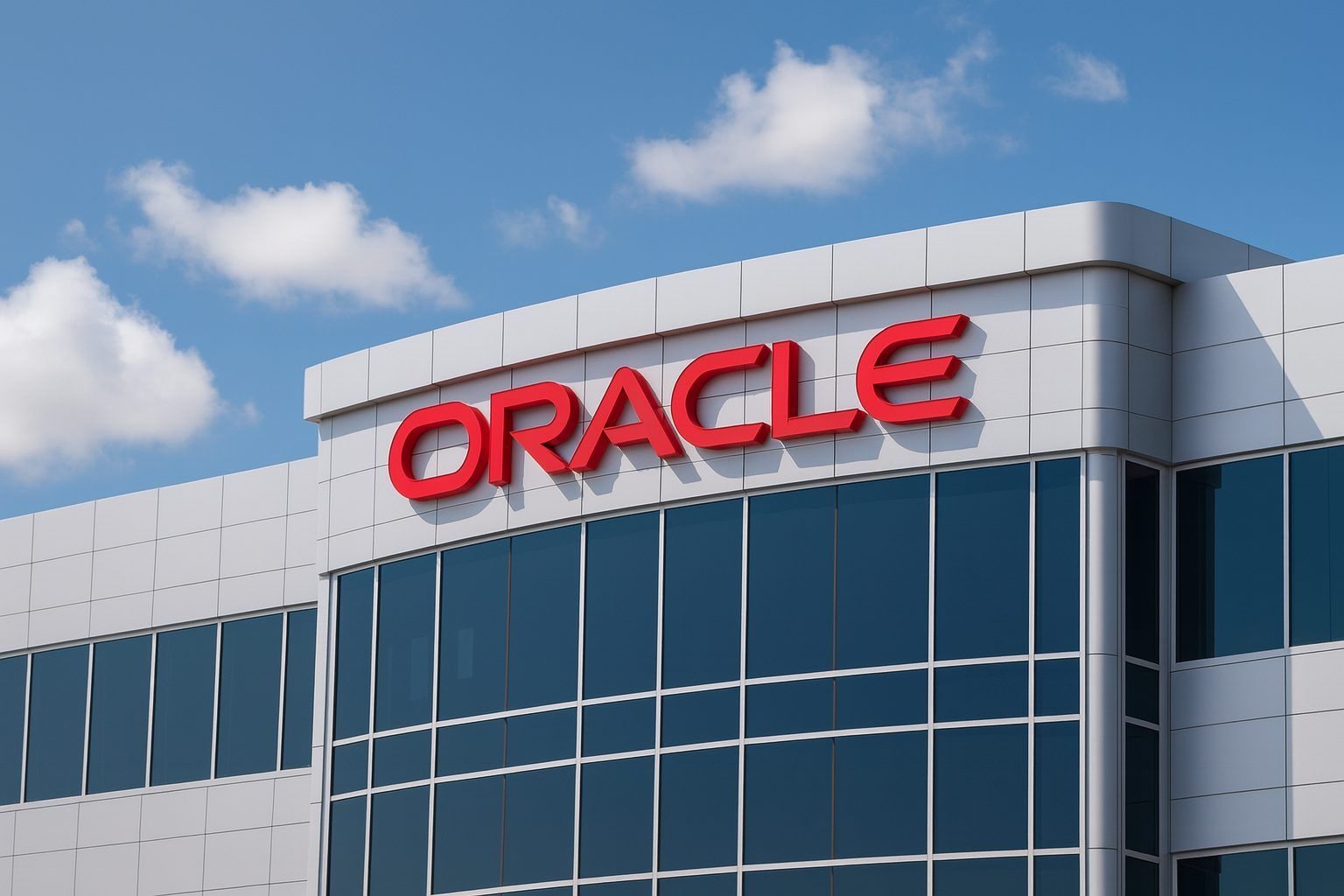Oracle Corporation (NYSE: ORCL) is bouncing on Wednesday after a brutal multi‑week sell‑off that wiped out roughly 40% of its value from September highs. As of mid-session, Oracle shares trade around $204.76, up about 3.9% versus Tuesday’s close, after touching an intraday low of $196 and a high of $211.45. [1]
Behind today’s move: a wave of fresh analyst support from Deutsche Bank and HSBC, new color on Oracle’s AI and cloud strategy, and continued interest from big institutional investors—even as concerns about debt, cash flow and its massive OpenAI exposure remain very much alive. [2]
Oracle stock price today: rebound after a steep slide
- Last price: ~$204.76 (midday Wednesday, Nov. 26, 2025)
- Day move: +$7.73 vs. prior close (~+3.9%)
- Intraday range: $196.00 – $211.45
- Recent performance: Still ~41% below its September peak, despite being more than 20% higher year‑to‑date. [3]
Wednesday’s rally comes after a month in which Oracle’s stock fell nearly 30%, driven by worries about its surging debt load, negative free cash flow and the sheer scale of its long‑term commitments to AI infrastructure—especially a headline $300 billion cloud deal with OpenAI. [4]
Why Oracle stock has been under pressure
The recent drawdown in ORCL is about more than just a hot AI trade cooling off. Several fundamental concerns have hit all at once:
1. Heavy debt for data‑center expansion
Oracle has added tens of billions of dollars in new borrowing to fund an aggressive global build‑out of AI‑ready data centers. That leverage has pushed up credit default swap (CDS) costs and widened spreads, signaling bond‑market unease about the balance sheet. [5]
MarketBeat data show Oracle with a debt‑to‑equity ratio around 3.33, which is high for a software company and leaves less room for error if AI demand slows or costs overrun. [6]
2. Negative free cash flow
To fund that infrastructure, free cash flow has swung negative—around –$5.9 billion, according to reporting cited by The Economic Times, marking one of the weakest cash‑flow periods for Oracle in decades. [7]
Negative free cash flow is not unusual in the middle of a big capacity build‑out, but it raises obvious questions: How long does this investment phase last, and will the promised AI revenue actually arrive on time and at the margins management is suggesting?
3. Concentration and timing risk around OpenAI
Oracle’s massive, multi‑year $300 billion cloud commitment with OpenAI has become a double‑edged sword:
- On the one hand, it underpins much of the surge in Oracle’s remaining performance obligations (RPO) and positions the company as a key AI infrastructure partner.
- On the other, investors worry about revenue timing, customer concentration, and the chance that OpenAI’s own path—or regulation around frontier AI—could disrupt Oracle’s forecasts. [8]
Those concerns, combined with a broader AI‑driven tech sell‑off since late October, helped drive Oracle sharply below the psychologically important $200 level, leaving the stock technically oversold. [9]
Wall Street steps in: Deutsche Bank and HSBC defend Oracle
Despite the recent damage, major Wall Street banks are doubling down on Oracle today, and that support is a big reason the stock is rebounding.
Deutsche Bank: “Bear case looks… bullish”
- Rating: Buy
- Price target:$375 (about 83% upside from around $205) [10]
- Key argument: The market is giving Oracle little credit for its OpenAI business at current prices.
Deutsche Bank ran a scenario that strips out OpenAI‑related revenue and expenses from Oracle’s long‑term guidance. On that basis, they estimate:
- FY2030 earnings per share would fall by about $4 to $17, and
- Free cash flow would drop by roughly $10 billion to $31 billion, compared with Oracle’s prior guidance. [11]
Even with that haircut, the bank argues that Oracle’s valuation still looks attractive, especially given its forward P/E of about 27—a multiple they see as weighed down by up‑front AI infrastructure costs that should pay off as the backlog converts into revenue. [12]
In a note that hit this morning, Deutsche Bank went so far as to say that the “bear case looks… bullish”—a deliberately provocative way of arguing that even pessimistic assumptions still support a higher share price. [13]
HSBC: Focus on how Oracle funds its build‑out
HSBC also reaffirmed a Buy rating today with a $382 price target, again implying substantial upside from the low‑$200s. [14]
Instead of focusing only on OpenAI, HSBC zooms in on funding strategy:
- Oracle has not detailed exactly how it will finance the next leg of its cloud infrastructure build‑out,
- but HSBC notes that capital‑intensive projects can use structures like special‑purpose vehicles or joint ventures—similar to Meta’s recent data‑center financing partnership with Blue Owl—to avoid bloating the balance sheet. [15]
The bank highlights that Oracle now has over $500 billion in remaining performance obligations and is aiming to preserve its investment‑grade credit rating while exploring those off‑balance‑sheet options. [16]
HSBC also flags mixed sentiment from other brokers:
- DA Davidson has a Neutral rating with a $200 target, effectively calling the stock fairly valued near current levels.
- BofA Securities has discussed an “OpenAI dilemma”: OpenAI is both a major cloud customer and a potential AI competitor, adding strategic uncertainty. [17]
Beyond OpenAI: $65B in new cloud deals and a Meta partnership
One important counter to the “single‑customer risk” narrative is that Oracle is landing huge AI cloud deals beyond OpenAI.
A detailed report from The Tech Buzz, updated today, notes that Oracle recently:
- Secured $65 billion in new cloud infrastructure commitments in just 30 days, across 7 contracts with 4 major customers.
- Confirmed Meta Platforms as one of those customers, validating earlier reports of a potential $20 billion Oracle–Meta tie‑up.
- Clarified that none of those $65 billion in contracts are with OpenAI, pushing back against fears that its backlog is overly dependent on a single AI client. [18]
Oracle projects its AI‑powered database and data platform revenue could jump from $2.4 billion in 2025 to around $20 billion by 2030, an eight‑fold increase powered by AI workloads. Management also points to AI infrastructure margins in the 30–40% range after data‑center costs, suggesting this business can be structurally profitable once the build‑out phase matures. [19]
This narrative—that Oracle is becoming a serious AI cloud alternative to AWS and Google Cloud rather than a niche player—underpins much of the bullish analyst commentary we’re seeing today. [20]
Fundamentals: massive backlog, fast‑growing cloud, pressured cash flow
Oracle’s latest reported quarter (Q1 FY 2026, ended Aug. 31, 2025) gives hard numbers behind the AI story:
- Total revenue: $14.9 billion, up 12% year‑over‑year.
- Cloud (IaaS + SaaS) revenue: $7.2 billion, up 28%.
- Cloud Infrastructure (IaaS): $3.3 billion, up 55%.
- Cloud Application (SaaS): $3.8 billion, up 11%.
- Remaining performance obligations (RPO): a staggering $455 billion, up 359% year‑over‑year. [21]
Management has laid out an extremely ambitious roadmap for Oracle Cloud Infrastructure (OCI):
- OCI revenue is expected to grow 77% to $18 billion this fiscal year,
- then to $32 billion, $73 billion, $114 billion and $144 billion over the following four years—most of which is already reflected in that RPO backlog. [22]
On the AI side, Oracle is also rolling out a new “Oracle AI Database” service, which will let customers run large language models from OpenAI, Google, xAI and others directly on top of their Oracle databases—explicitly pitching this as a way for thousands of existing database customers to “unlock” AI value from their existing data. [23]
The catch: this explosive growth outlook requires huge up‑front capital spending, which is exactly what’s depressing free cash flow and spooking credit markets right now. [24]
What big investors and insiders are doing with ORCL
Today’s filings and disclosures show a mixed but generally supportive picture from institutional and political money.
Boston Partners: Oracle is a top‑10 position
A new MarketBeat summary of 13F filings shows Boston Partners:
- Increased its Oracle stake by 0.8% in Q2, buying ~38,000 additional shares.
- Now holds 4,813,379 ORCL shares, worth about $1.06 billion at the time of filing.
- Makes Oracle 1.2% of its portfolio and its 7th‑largest position, representing about 0.17% of Oracle’s shares outstanding. [25]
Russell Investments: incremental buying
Russell Investments Group has also been adding:
- It lifted its holdings by 2.6% in Q2, purchasing 45,598 additional shares.
- Russell now owns 1,766,772 Oracle shares, about 0.06% of the company, valued at roughly $384 million at the time of the filing. [26]
Across these and other funds, institutional investors and hedge funds own about 42% of Oracle’s stock, a level that still leaves substantial room for either accumulation or rotation. [27]
Congressional trading: small sale from Rep. Lisa McClain
On the political front, a new disclosure shows Representative Lisa C. McClain (R‑Michigan) sold between $1,001 and $15,000 of Oracle stock on October 30, reported in a filing dated November 21. The transaction came alongside similarly sized sales in several other large‑cap names, including Alibaba, Clorox and Honda. [28]
For a $500‑plus‑billion company, that trade is economically tiny, but it contributes to the narrative that some investors have been trimming tech and AI exposure into volatility.
Valuation, analyst consensus and technical backdrop
Despite the pullback, Oracle does not look like a classic “deep value” stock on traditional metrics:
- Trailing P/E: around 45–46. [29]
- Consensus rating:“Moderate Buy”, with MarketBeat tracking
- 3 analysts at Strong Buy,
- 27 at Buy,
- 10 at Hold, and
- 2 at Sell. [30]
- Average 12‑month price target: roughly $319–322, implying about 55–60% upside from the low‑$200s. [31]
On the technical side, MarketBeat estimates Oracle’s Relative Strength Index (RSI) at about 26 on a one‑year look‑back—firmly in “oversold” territory (below 30)—after a correction of roughly 34% since mid‑September. Short interest is relatively low at around 1.2% of float, suggesting that most of the selling pressure has come from long investors de‑risking rather than outright bear speculation. [32]
Key risks investors should keep in mind
Even with today’s bounce and bullish notes, Oracle stock is far from a low‑risk story. Key issues to monitor include:
- Execution risk on AI infrastructure
Oracle must turn its massive backlog and multiyear commitments into profitable, on‑time capacity—no small feat given supply constraints for advanced chips, power and real estate. - Leverage and interest‑rate sensitivity
With a debt‑to‑equity ratio above 3, higher funding costs or any slowdown in cash generation could pressure both earnings and the company’s investment‑grade rating. [33] - OpenAI and customer concentration
The $300 billion OpenAI commitment is both an opportunity and a concentration risk. Any change in OpenAI’s trajectory, competitive position, or regulatory environment could ripple through Oracle’s long‑term AI plans. [34] - Valuation risk
A mid‑40s P/E multiple means Oracle is still priced for substantial growth. If margins remain under pressure longer than expected or AI spending slows, there is room for further multiple compression. [35] - Macro and AI sentiment
Recent commentary has framed parts of the market as dealing with an “AI bubble‑induced sell‑off.” If risk appetite continues to fade, even strong fundamentals may not prevent further volatility in highly valued AI‑linked names like Oracle. [36]
What to watch next for Oracle stock
For traders and long‑term investors tracking ORCL, the next few months will likely hinge on:
- Next earnings update (Q2 FY 2026):
How quickly are RPO and mega‑deals converting to revenue? Do margins begin to stabilize as utilization improves? [37] - Funding strategy announcements:
Any concrete move toward joint‑venture or SPV structures—similar to Meta’s financing of its data centers—could reassure investors about balance‑sheet risk. [38] - Further analyst revisions:
Additional upgrades or downgrades, especially from large U.S. banks, could drive sentiment as the market decides whether the recent drawdown was an overreaction. [39] - Macro backdrop:
Expectations for U.S. rate cuts, tech sector flows and AI‑related regulation will all influence how much tolerance investors have for high‑capex, high‑multiple stories like Oracle. [40]
Bottom line: Oracle stock today
On November 26, 2025, Oracle stock is trying to stage a comeback:
- The fundamentals—huge RPO, fast‑growing cloud, multi‑billion‑dollar AI deals with customers like Meta—support the bulls’ argument that the business is in its strongest growth phase in decades. [41]
- The financial and strategic risks—high leverage, negative free cash flow, and dependence on a handful of massive AI contracts—explain why the market has been so ruthless over the last month. [42]
- Analysts at Deutsche Bank and HSBC clearly believe the sell‑off has gone too far, with price targets in the $375–$382 range and a view that even conservative scenarios justify much higher levels over time. [43]
For investors, Oracle now sits in that uncomfortable zone between fear and FOMO: the downside risks are real and visible, but so is the potential upside if AI infrastructure demand continues to surge and Oracle executes on its backlog.
As always, this article is informational only and not financial advice. Anyone considering ORCL should weigh these opportunities and risks against their own time horizon, risk tolerance and portfolio needs.
References
1. www.tradingview.com, 2. www.investing.com, 3. www.tradingview.com, 4. m.economictimes.com, 5. m.economictimes.com, 6. www.marketbeat.com, 7. m.economictimes.com, 8. m.economictimes.com, 9. m.economictimes.com, 10. www.investing.com, 11. www.tradingview.com, 12. www.tradingview.com, 13. www.investing.com, 14. www.investing.com, 15. www.investing.com, 16. www.investing.com, 17. www.investing.com, 18. www.techbuzz.ai, 19. www.techbuzz.ai, 20. www.techbuzz.ai, 21. www.oracle.com, 22. www.oracle.com, 23. www.oracle.com, 24. m.economictimes.com, 25. www.marketbeat.com, 26. www.marketbeat.com, 27. www.marketbeat.com, 28. www.marketbeat.com, 29. www.marketbeat.com, 30. www.marketbeat.com, 31. www.marketbeat.com, 32. www.marketbeat.com, 33. www.marketbeat.com, 34. m.economictimes.com, 35. www.marketbeat.com, 36. www.marketbeat.com, 37. www.oracle.com, 38. www.investing.com, 39. 247wallst.com, 40. 247wallst.com, 41. www.oracle.com, 42. m.economictimes.com, 43. www.investing.com







